Abstract
The role of carbonic anhydrase in de novo lipid synthesis was examined by measuring [1-14C]acetate incorporation into total lipids, fatty acids and non-saponifiable lipids in freshly isolated rat hepatocytes. Two carbonic anhydrase inhibitors, trifluoromethylsulphonamide (TFMS) and ethoxozolamide (ETZ) decreased incorporation of 14C into total lipids. Both fatty acid and non-saponifiable lipid components of the total lipid were inhibited to approximately the same extent by 100 microM TFMS (29 +/- 0.3% and 35 +/- 0.3% of control respectively in replicate studies). However, neither drug significantly affected ATP concentrations or the transport activity of Na+/K(+)-ATPase, two measures of cell viability. To establish the site of this inhibition, water-soluble 14C-labelled metabolites from perchloric acid extracts of the radiolabelled cells were separated by ion-exchange chromatography. TFMS inhibited 14C incorporation into citrate, malate, alpha-oxoglutarate and fumarate, but had no effect on incorporation of 14C into acetoacetate. Since ATP citrate-lyase, the cytosolic enzyme that catalyses the conversion of citrate into acetyl-CoA, catalyses an early rate-limiting step in fatty acid synthesis, levels of cytosolic citrate may be rate controlling for de novo fatty acid and sterol synthesis. Indeed citrate concentrations were significantly reduced to 37 +/- 6% of control in hepatocytes incubated with 100 microM TFMS for 30 min. TFMS also inhibited the incorporation of 14C from [1-14C]pyruvate into malate, citrate and glutamate, but not into lactate. This supports the hypothesis that TFMS inhibits pyruvate carboxylation, i.e. since all of the 14C from [1-14C]pyruvate converted into citric acid cycle intermediates must come via pyruvate carboxylase (i.e. rather than pyruvate dehydrogenase). Our findings indicate a role for carbonic anhydrase in hepatic de novo lipogenesis at the level of pyruvate carboxylation.
Full text
PDF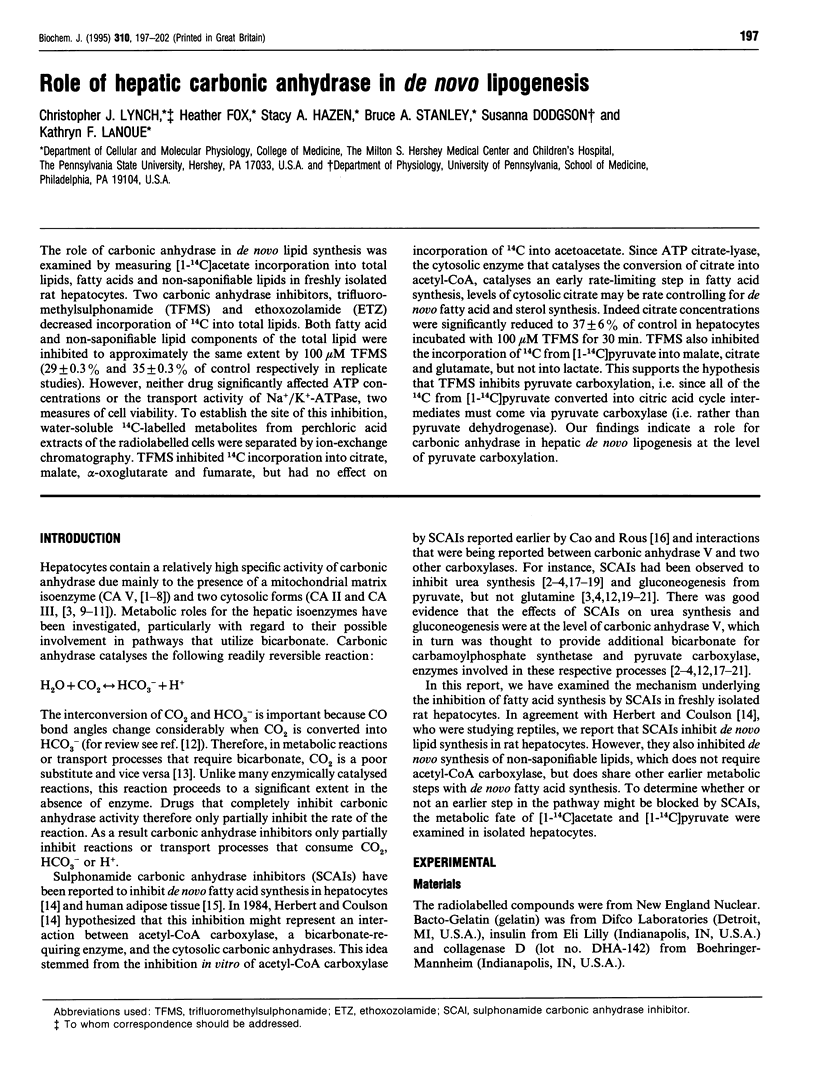
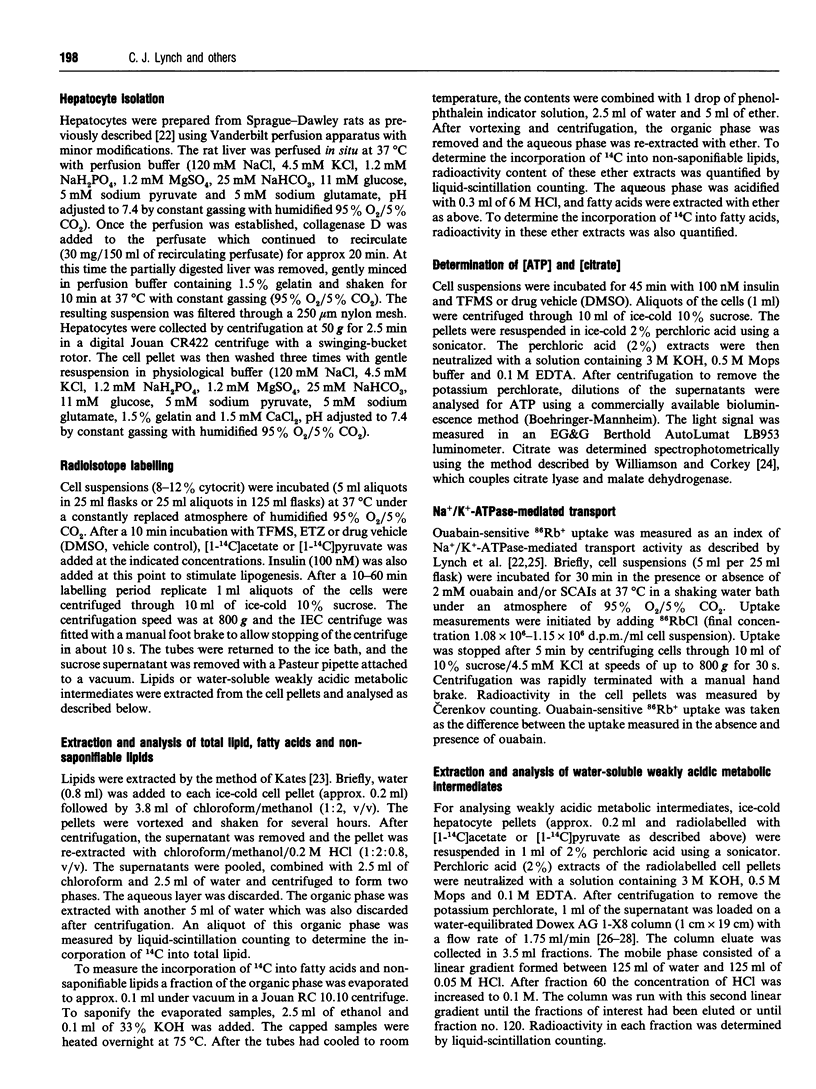

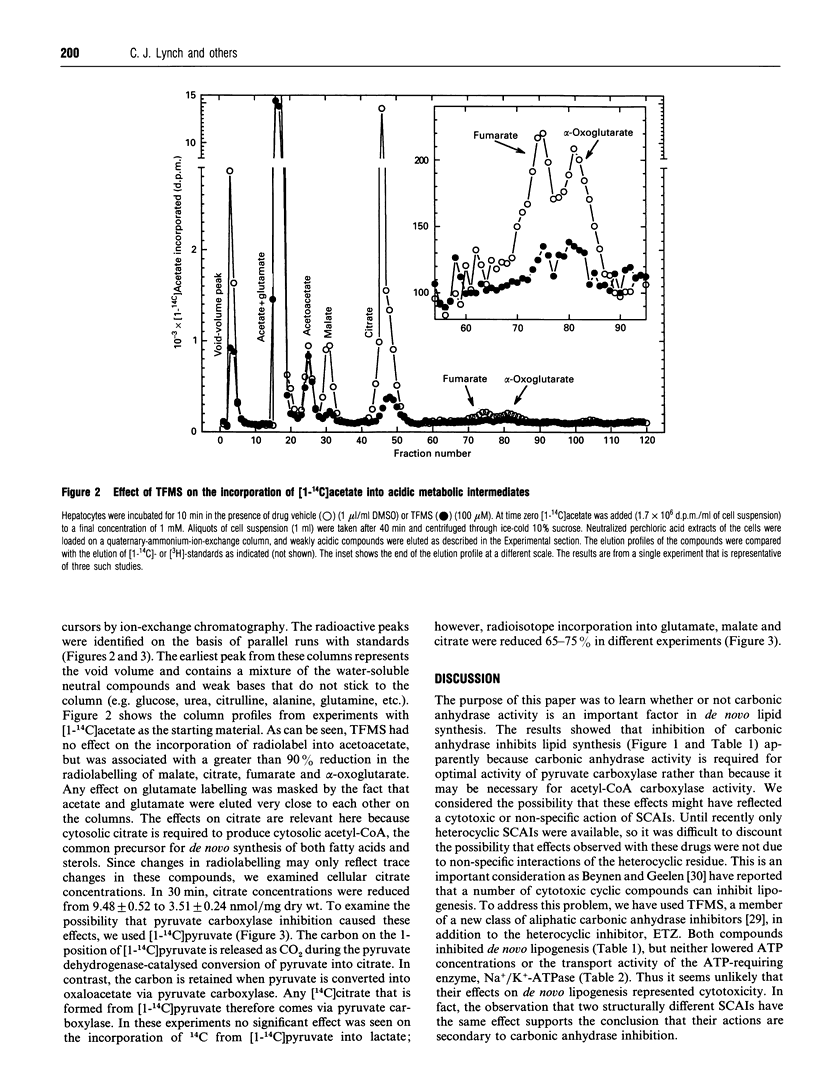
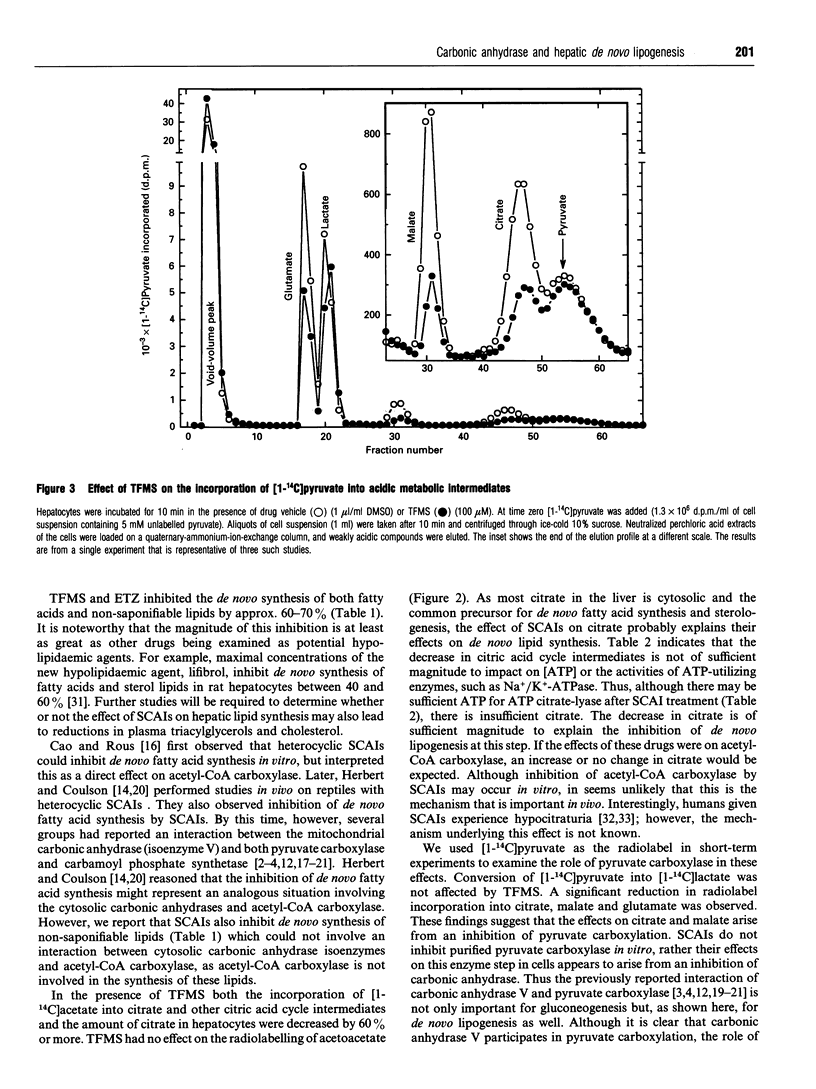
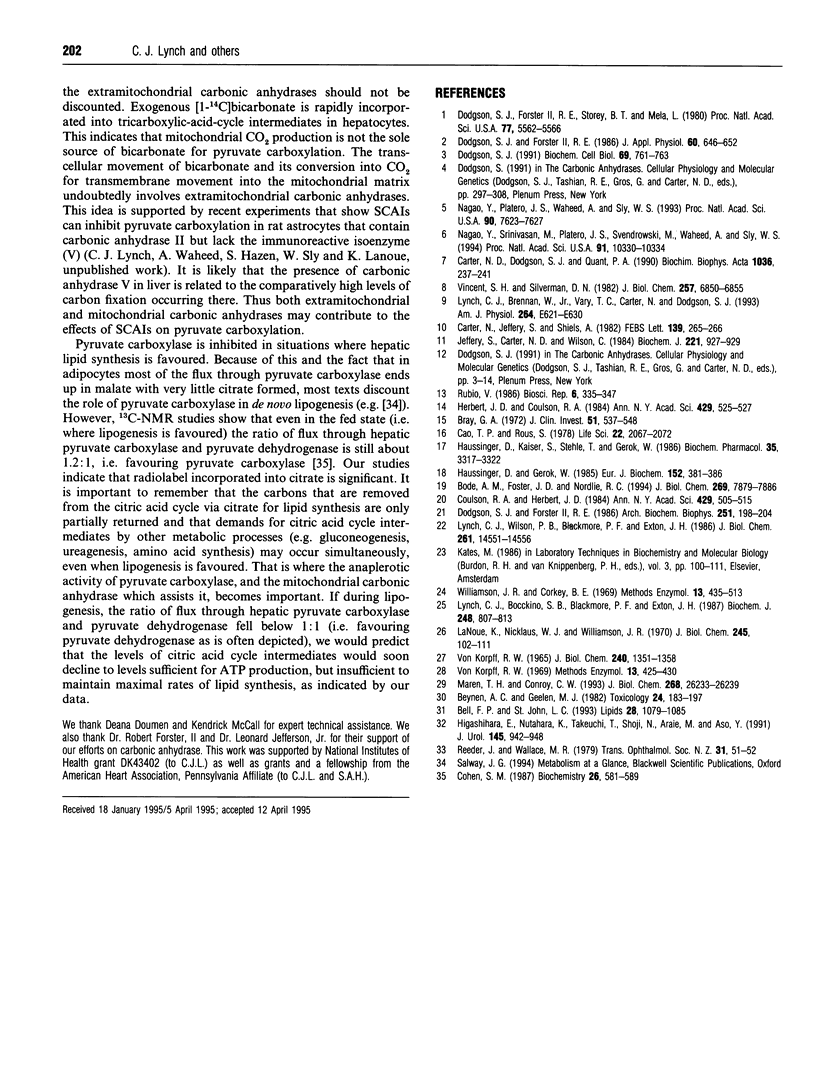
Selected References
These references are in PubMed. This may not be the complete list of references from this article.
- Bell F. P., St John L. C. Action of the new hypolipidemic agent lifibrol (K12.148) on lipid homeostasis in normal rats: plasma lipids, hepatic sterologenesis, and the fate of injected [14C]acetate. Lipids. 1993 Dec;28(12):1079–1085. doi: 10.1007/BF02537074. [DOI] [PubMed] [Google Scholar]
- Beynen A. C., Geelen M. J. Short-term inhibition of fatty acid biosynthesis in isolated hepatocytes by mono-aromatic compounds. Toxicology. 1982;24(3-4):183–197. doi: 10.1016/0300-483x(82)90001-4. [DOI] [PubMed] [Google Scholar]
- Bode A. M., Foster J. D., Nordlie R. C. Glycogenesis from glucose and ureagenesis in isolated perfused rat livers. Influence of ammonium ion, norvaline, and ethoxyzolamide. J Biol Chem. 1994 Mar 18;269(11):7879–7886. [PubMed] [Google Scholar]
- Bray G. A. Lipogenesis in human adipose tissue: some effects of nibbling and gorging. J Clin Invest. 1972 Mar;51(3):537–548. doi: 10.1172/JCI106842. [DOI] [PMC free article] [PubMed] [Google Scholar]
- Cao T. P., Rous S. Inhibitory effect of acetazolamide on the activity of acetyl CoA carboxylase of mouse liver. Life Sci. 1978 Jun 19;22(23):2067–2071. doi: 10.1016/0024-3205(78)90449-6. [DOI] [PubMed] [Google Scholar]
- Carter N. D., Dodgson S. J., Quant P. A. Expression of hepatic mitochondrial carbonic anhydrase V. Biochim Biophys Acta. 1990 Dec 6;1036(3):237–241. doi: 10.1016/0304-4165(90)90040-4. [DOI] [PubMed] [Google Scholar]
- Carter N., Jeffery S., Shiels A. Immunoassay of carbonic anhydrase III in rat tissues. FEBS Lett. 1982 Mar 22;139(2):265–266. doi: 10.1016/0014-5793(82)80866-1. [DOI] [PubMed] [Google Scholar]
- Cohen S. M. 13C NMR study of effects of fasting and diabetes on the metabolism of pyruvate in the tricarboxylic acid cycle and the utilization of pyruvate and ethanol in lipogenesis in perfused rat liver. Biochemistry. 1987 Jan 27;26(2):581–589. doi: 10.1021/bi00376a033. [DOI] [PubMed] [Google Scholar]
- Coulson R. A., Herbert J. D. A role for carbonic anhydrase in intermediary metabolism. Ann N Y Acad Sci. 1984;429:505–515. doi: 10.1111/j.1749-6632.1984.tb12379.x. [DOI] [PubMed] [Google Scholar]
- Dodgson S. J., Forster R. E., 2nd Carbonic anhydrase: inhibition results in decreased urea production by hepatocytes. J Appl Physiol (1985) 1986 Feb;60(2):646–652. doi: 10.1152/jappl.1986.60.2.646. [DOI] [PubMed] [Google Scholar]
- Dodgson S. J., Forster R. E., 2nd Inhibition of CA V decreases glucose synthesis from pyruvate. Arch Biochem Biophys. 1986 Nov 15;251(1):198–204. doi: 10.1016/0003-9861(86)90066-4. [DOI] [PubMed] [Google Scholar]
- Dodgson S. J., Forster R. E., 2nd, Storey B. T., Mela L. Mitochondrial carbonic anhydrase. Proc Natl Acad Sci U S A. 1980 Sep;77(9):5562–5566. doi: 10.1073/pnas.77.9.5562. [DOI] [PMC free article] [PubMed] [Google Scholar]
- Dodgson S. J. Why are there carbonic anhydrases in the liver? Biochem Cell Biol. 1991 Dec;69(12):761–763. doi: 10.1139/o91-116. [DOI] [PubMed] [Google Scholar]
- Herbert J. D., Coulson R. A. A role for carbonic anhydrase in de novo fatty acid synthesis in liver. Ann N Y Acad Sci. 1984;429:525–527. doi: 10.1111/j.1749-6632.1984.tb12381.x. [DOI] [PubMed] [Google Scholar]
- Häussinger D., Gerok W. Hepatic urea synthesis and pH regulation. Role of CO2, HCO3-, pH and the activity of carbonic anhydrase. Eur J Biochem. 1985 Oct 15;152(2):381–386. doi: 10.1111/j.1432-1033.1985.tb09208.x. [DOI] [PubMed] [Google Scholar]
- Jeffery S., Carter N. D., Wilson C. Carbonic anhydrase II isoenzyme in rat liver is under hormonal control. Biochem J. 1984 Aug 1;221(3):927–929. doi: 10.1042/bj2210927. [DOI] [PMC free article] [PubMed] [Google Scholar]
- LaNoue K., Nicklas W. J., Williamson J. R. Control of citric acid cycle activity in rat heart mitochondria. J Biol Chem. 1970 Jan 10;245(1):102–111. [PubMed] [Google Scholar]
- Lynch C. J., Bocckino S. B., Blackmore P. F., Exton J. H. Calcium-mobilizing hormones and phorbol myristate acetate mediate heterologous desensitization of the hormone-sensitive hepatic Na+/K+ pump. Biochem J. 1987 Dec 15;248(3):807–813. doi: 10.1042/bj2480807. [DOI] [PMC free article] [PubMed] [Google Scholar]
- Lynch C. J., Brennan W. A., Jr, Vary T. C., Carter N., Dodgson S. J. Carbonic anhydrase III in obese Zucker rats. Am J Physiol. 1993 Apr;264(4 Pt 1):E621–E630. doi: 10.1152/ajpendo.1993.264.4.E621. [DOI] [PubMed] [Google Scholar]
- Lynch C. J., Wilson P. B., Blackmore P. F., Exton J. H. The hormone-sensitive hepatic Na+-pump. Evidence for regulation by diacylglycerol and tumor promoters. J Biol Chem. 1986 Nov 5;261(31):14551–14556. [PubMed] [Google Scholar]
- Maren T. H., Conroy C. W. A new class of carbonic anhydrase inhibitor. J Biol Chem. 1993 Dec 15;268(35):26233–26239. [PubMed] [Google Scholar]
- Nagao Y., Platero J. S., Waheed A., Sly W. S. Human mitochondrial carbonic anhydrase: cDNA cloning, expression, subcellular localization, and mapping to chromosome 16. Proc Natl Acad Sci U S A. 1993 Aug 15;90(16):7623–7627. doi: 10.1073/pnas.90.16.7623. [DOI] [PMC free article] [PubMed] [Google Scholar]
- Nagao Y., Srinivasan M., Platero J. S., Svendrowski M., Waheed A., Sly W. S. Mitochondrial carbonic anhydrase (isozyme V) in mouse and rat: cDNA cloning, expression, subcellular localization, processing, and tissue distribution. Proc Natl Acad Sci U S A. 1994 Oct 25;91(22):10330–10334. doi: 10.1073/pnas.91.22.10330. [DOI] [PMC free article] [PubMed] [Google Scholar]
- Reeder J., Wallace M. R. The effect of carbonic anhydrase inhibitors on urinary calcium and citrate. Trans Ophthalmol Soc N Z. 1979;31:51–52. [PubMed] [Google Scholar]
- Rubio V. Enzymatic HCO3- fixation: a common mechanism for all enzymes involved? Biosci Rep. 1986 Apr;6(4):335–347. doi: 10.1007/BF01116420. [DOI] [PubMed] [Google Scholar]
- VONKORFF R. W. METABOLIC CHARACTERISTICS OF ISOLATED RABBIT HEART MITOCHONDRIA. J Biol Chem. 1965 Mar;240:1351–1358. [PubMed] [Google Scholar]
- Vincent S. H., Silverman D. N. Carbonic anhydrase activity in mitochondria from rat liver. J Biol Chem. 1982 Jun 25;257(12):6850–6855. [PubMed] [Google Scholar]


